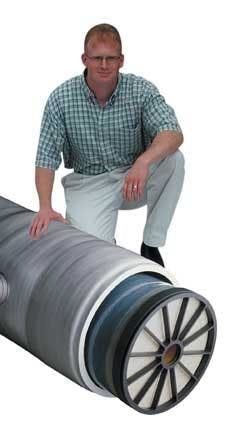Koch developed the MegaMagnum™ the world's largest RO element.
Click here to enlarge imageResearch conducted by the Metropolitan Water District of Southern California (USA) to evaluate ways to lower RO desalination costs led to the development of the world's largest RO element. Koch Membrane Systems developed these large-diameter prototype elements for field test studies for Metropolitan, and recently launched the Fluid Systems™ MegaMagnum™ designed for large-scale seawater desalination and brackish water purification applications.
Few changes in spiral wound design have occurred since the introduction of the standard 8-inch diameter element 30 years ago for treating highly saline potable water.
Conventional water treatment plants, like other chemical process plants, are able to achieve cost reductions with increased plant size by using larger components such as pumps, valves or filters. This option has not been available to designers using RO systems because they were forced to use a fixed size of membrane components, which were inappropriate to the scale of the plant. For example, a 150-million gallon per day (mgd) RO plant typically requires 24,000 standard 8-inch diameter by 40-inch-long spiral wound elements. Little additional economy of scale can be achieved for a very large water treatment facility requiring so many individual pieces of equipment.
Koch Membrane Systems recognised this in the 1980s when it introduced the Fluid Systems Magnum™, an 8-inch by 60-inch long element. The same plant would require 16,000 of these elements for the above example.
As municipalities began to develop larger treatment plants to handle increased potable water requirements, a larger scale of RO hardware was necessary to keep the process more cost effective. One of the first organisations to recognise this was the Metropolitan Water District of Southern California, a Los Angeles-based government agency that imports and wholesales about half of the drinking water used by more than 17 million people in a 5,200 square-mile area. The district imports water from the Colorado River and from Northern California to supplement local supplies.
Colorado River water (CRW) is one of Metropolitan's primary source waters. The total dissolved solids (TDS) of CRW ranges between 520 milligrams per litre (mg/l) to 727 mg/l and is predicted to reach upwards of 750 mg/l. The use of brackish water such as CRW incurs significant economic damages to Metropolitan's service area. Metropolitan began evaluating options for lowering the cost of RO desalination as part of an effort to develop long-term strategies for meeting CRW water quality and supply goals.
Metropolitan's research, using elements constructed by Koch Membrane Systems evaluated several generations of new, large-diameter RO elements. Each element has approximately six times more surface area than the commercially available, 8-inch by 40-inch element. The outcome of this research prompted Koch Membrane Systems to commercially launch the Fluid Systems MegaMagnum, which offers significant economies of scale for large seawater desalination plants and brackish water purification applications.




